MF fix focal 18mm – 85mm
Nikon manual focus fix-focal lenses 18mm to 85mm
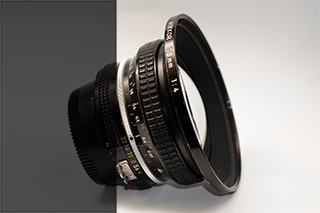
AI 18mm 4.0
Introduced in 1974 as a K lens design, this lens was updated to AI mount in 1977. Known serial numbers indicate that slightly more K lenses than native AI lenses were produced. In total production should be a little less or around 10.000 lenses. Price in Germany (1979): 1199,- DM, inflation adjusted 2012: 1260 €
Appearance and mechanical construction are very nice. The unusual large diameter of the filter (86mm !) and focus ring make this lens stand out among the wide fix-focals. The build quality is on a very high level. In the original state the lens comes with a metal 86mm screw-in lens cap and a very wide and shallow lens hood, the HN-15. Unfortunately you can not mount the original lens cap and hood at the same time, which is to be expected with a metal screw-in cap. But even with a modern center-pinch cap you can not mount both at the same time, since the hood is not threaded on the inside. Because of the bulbous front lens it is recommended to use a lens cap during transport.
The photographer has to adapt to the weaknesses of this lens depending on the sensor the lens is used on. Regardless of sensor the vignetting is the biggest problem. Wide open and at f/5,6 the darkening impacts most of the frame. At f/8 the darkeing reaches a level where it is possible to either live with it, or is easily corrected in post processing. The darkening is a little more intense on the older 12 MP full frame sensor. With the D800 the issue is still present, but a little less prominent.
Regarding sharpness the situation is quite the opposite. On the 12 MP sensor sharpness is excellent in the center even wide open and good in the corners at f/8. On 36 MP the sides of the frame (field curvature) and the corners leave a bit to be desired up to f/8, while at the same time the center sharpness reaches only a very good level. The resolution limit of the lens is exceeded at 36 MP.
Color and contrast are handeled very nicely. Overall the rendering is quite nice. Distortion is present but in line with the focal length.
In my opinion this lens is a better 20mm lens. If you crop the frame slightly, you still get at least the same or a little wider view than with 20mm and have an overall pleasing picture quality. Stopped down to f/11 this lens should suit most demands across the frame. Or put in another way: if you use this lens on the D800 at f/8, cut away the problematic portions in the corners through cropping, you get a better picture than with the 20mm 3,5. On the D700 corner sharpness is a non-issue already by f/8. However the vignetting is percieved a little bit stronger due to older sensor technology.
Samples (FX / 36MP): 18mm f/4,0 18mm f/8 18mm f/11 18mm f/8
Samples (DX / 20MP): 18mm f/5,6 18mm f/5,6
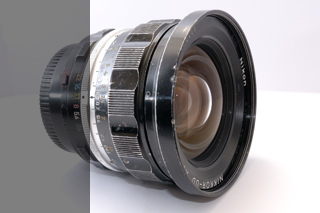
F 20mm 3.5 UD
This lens is something what some people like to call a “beater”. I bought it in a mechanically very miserable condition with clean and immaculate lenses. First I had some reservations to put a review of this lens online. It took me almost a whole weekend to repair the internal mechanics. The most severe issue was a broken retention cam. After a complete disassembly (despite lens groups, of course) I am now confident that this lens is still properly aligned and mechanically sound. However, there are many better samples of this lens out there that might perform better.
Even this battled sample gives the feeling of a very solid build – apart from the fact that the cam holding the lens barrel into position while focusing is apparently too weak. It is much heavier than the AI-S 20mm 3,5 lens below and with a filter diameter of 72mm much bigger in width.
The lens is sharp even wide open – but only in the center. Towards the borders performance drops rapidly and a high degree of vignetting creates the impression of a “tunnel view”. This vignetting is very problematic at f/3,5 and f/4, drops to a manageable level at f/5,6 and is finally not a big issue any more at f/8. For best corner performance stop down to f/11.
Let me point out once again that the center portion of the frame is quite astonishing. Therefore, on DX this lens fares much better. Usable from f/5,6 on DX without any serious issues.
Samples (FX / 12MP): 20mm f/3,5 20mm f/3,5 20mm f/8

AI-S 20mm 3.5
This lens is the successor to the earlier Nikkor 20mm 4.0. It remained in production only for seven years before it was replaced by the 20mm 2,8 version. About 30.000 AI and 30.000 AI-S lenses were produced between 1977 and 1984. Price: US (1985): 361 $, Germany (1984): 600 DM, inflation adjusted 2012: 506 €
Unlike its successor this lens does not feature the CRC mechanism for improved close-up shooting. The lens is sharp from f/3.5 in the centre. The corner sharpness is exellent in the close range up to 10 metres but unfortunately the corner sharpness with more distant objects is not very good at all. Stopped down to f/11 and focused at infinity the corners are still smeared on DX, modern zooms perform much better than this at wider apertures. On FX corners are a just barely acceptable at f/8 and you have to stop down to f/11 to achieve results without complaining. It seems to me that this lens is optimized for exellent performance at closer distances. The lens is realtively flare resistant and you will have trouble to get ghosting with it. CA is visible.
I have mixed feelings about this lens. First of all the lack of speed because of the maximum aperture of only 3.5 and the lack of CRC makes this lens only a mediocre choice in the wide angle range. The 20mm 2.8 is supposed to be much better, but in my experience both are not very suitable for digital shooters. The small rear lens element on both lenses causes the light to hit the sensor at an angle, which leads to the poor corner performance and CA mentioned above. In my opinion modern zooms are better than the old 20mm primes.
Samples (DX / 10 MP): 20mm f/11 20mm f/5,6
Samples (FX / 36 MP): 20mm f/8
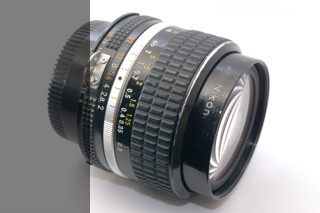
AI-S 24mm 2.0
Price in Germany 1984: 799,- DM, inflation adjusted 2012: 673 €. Introduced as AI lens in 1977, updated to AI-S in 1981 and in the lineup up to 2005 with presumably 70.000 lenses made.
The physical appearance is very similar to the 24mm 2,8, just a slightly longer inner lens barrel and a larger front lens element hint at the faster speed. The lens is also slightly heavier as one might guess.
Some key characteristics of Nikons superspeed-lenses of the 70’s are present here, too. Most notably the internal flare that causes softness and a dreamy look wide open in connection with light sources or bright objects. Unlike the 35mm 1,4 this becomes a very big problem with this lens. It is very hard to obtain reasonably sharp images at f/2,0.
Unfortunately this lens performs very poorly on FX. The borders can’t be called sharp until you stop down to f/5,6 and one further stop is needed to obtain good sharpness across the frame. Vignetting is pretty bad wide open, bad at f/2,8 and still visible at f/4.
On DX you gain profit from the reduced image circle. On a D200 the softness wide open becomes more visible, but overall it is a pretty good lens with even sharpness across the frame from f/2,8 on.
Ghosting is a bit more problematic as with the 24mm 2,8. Overall colors and contrast are pretty good stopped down. To sum it up: Use it on FX from f/5,6 or even f/8 on, DX is fine already at f/4.
Sorry Nikon, this isn’t your best.
Samples (FX / 36 MP): 24mm f/2,8
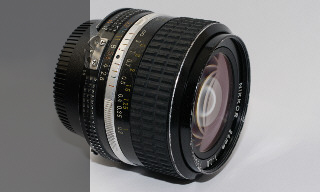
AI-S 24mm 2.8
The 24mm 2.8 is a real classic in the Nikon lens lineup and it was very popular in the film days. The first version appeared in 1967 and introduced the CRC-mechanism for close range focus. The optical formula was changed only once in 1977 when the lens was re-issued as AI-lens. A total of 320.000 AI and AI-S versions were made and the lens is still in production, new serial numbers for the production run starting in 2006 are beginning with a “9”. Price: US (1985): 318 $, Germany (1983): 450 DM, inflation adjusted 2012: 389 €.
This lens works much better on digital than the 20mm lens. If you can give up the extra mm’s on the wide end this lens might be the better pick and a starting point for a 24mm, 35mm (optional), 50mm, 105mm, 200mm lens kit.
The lens is very sharp in the middle of the frame at closer distances even wide open on DX and FX, stopping down to f/5.6 brings the corners up to a very good level on DX. On FX vignetting is an issue up to f/5.6 and the corners start to clear up only at f/8, becoming good at f/11. Contrast can be a little bit low in backlit situations. Some reviewers complain about CA issues, I couldn’t verify this so far. CA is present, but not more than expected for an older design. The performance for landscape shooting is decent, but not as good or better than a modern f/2,8 zoom from any manufacturer.
The lens is a bit difficult to focus. Even with a split-prism screen it is difficult to set the DOF zone to the right spot at wider apertures. I recommend to use the DOF marks and the distance scale on the lens to calculate the focus position.
Sample (DX / 10 MP): 24mm f/8
Sample (FX / 36 MP): 24mm f/5,6

AI-S 28mm 2.0
This lens was produced between 1975 and 2005 in many different versions from non-AI (Nikkor K) to AI-S. Total production is somewhere between 80.000 and 90.000 lenses. Price: US (1985): 464 $, Germany (1984): 790 DM, inflation adjusted 2012: 666 €. This lens, which features CRC, is an excellent performer even wide open. It is one of the best 28mm Nikkors available and highly recommended!
Samples (FX / 36 MP): 28mm f2,0 28mm f5,6
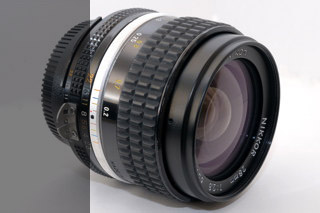
AI-S 28mm 2.8
Total production of AI-S lenses is at more than 200.00 copies right now. The lens is officially still in production albeit one could argue that Nikon simply sells off old stock until it is depleted. Price: US (1985): 292 $, Germany (1984): 490 DM, inflation adjusted 2012: 413 €.
It is very important to note that this 28mm is the AI-S version because Nikon changed the lens design considerably while making the switch from AI to AI-S. The lens now features a close focus of 0,2m while the older lens “only” offers the ability to focus as close as 0,3m. On top of that Nikon included the CRC mechanism in the AI-S lens creating a totally different optical formula compared to the predecessors and compared to the newer autofocus lenses which feature a simpler optical design.
Amongst many reviewers this lens is deemed as the best 28mm fixed focal lens that Nikon ever produced. I tend to agree, but often prefer the faster Nikkor 28mm 2,0 just because of the faster speed. If you don’t need the faster aperture or if you want to save a few bucks there is nothing to say against this lens. It truly excels in landscape photography and is a perfect lens for that purpose.
Overall the sharpness is very good across the aperture range. In the close range the lens is sharp even at f/2,8 whereas for longer distances f/4 is recommended to get it up to a very good level. At apertures from f/5,6 to f/11 sharpness is as good as it can get with any lens. Colour fringing is only a problem at f/2,8 and disappears quickly. CA is not big problem and the distortion characteristic is a bit better than average, too.
The compact appearance and the relatively low weight make this lens ideal for general photography. Please read below an update regarding 36MP FX.
Sample (DX / 10 MP): 28mm f/4
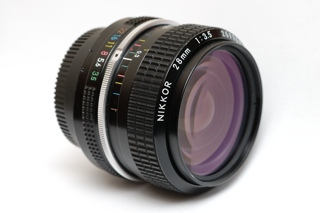
K/AI 28mm 3.5
The 28mm 3,5 was the first offering of this focal length in the lineup, shortly after the introduction of the Nikon F. It was built between 1960 and 1983 in different mechanical variants. Optical construction was not changed during the times. More than 600.000 produced lenses speak for the huge popularity of the 28mm 3,5. The popularity of the lens was based on the moderate price and physical robustness.
The variant tested here is member of the K-series (rubber focus ring, but no native AI coupling yet) and was offered between 1975 and 1977.
Sharpness is already quite good in the center of the frame from wide open, even on the D800. From f/5,6 the center is almost perfect. However, image borders lag behind and become good (not excellent) at f/8 On DX sharpness is good across the frame at f/5,6 already.
Aberrations like coma and CA are surprisingly not an issue, not even with bright objects and open aperture.
The most problematic aspect is vignetting, which even impacts the metering on FY and DX. Matrix metering is not usable unless negative exposure compensation is dialed in. If not compensated, the light fallow wide open leads to a massive overexposure when stopped down. Due to this, center weighted metering is recommended with the 28mm 3,5. Vignetting is visible on FX until f/8 and f/5,6 on DX.
The two other 28mm alternatives (2,8 and 2,0) in the Nikon lineup are optically better, and this by quite a margin.
Sample (): –

AI NC-Auto 35mm 1.4 (factory converted to AI)
Produced approximately 110.000 times between 1970 and 2005. The AI-S version has 9 aperture blades while the earlier versions have mostly only 7 blades. The AI-S version is more common with a total production of 70.000 lenses. Price: US (1985): 506 $, Germany (1984): 860 DM, inflation adjusted 2012: 725 €.
My early 7-blade NC-Nikkor is the first multi-coated version of this lens and was produced between 1973 and 1976 (about 8000 lenses of this type were made). Lenses which were originally produced as non-AI have a glass element containing Thorium glass. This glass type is slightly radioactive and the glass turns yellow over time. My sample had a very easy to detect yellow cast, visible even in the viewfinder. The yellow colouring is reversible with UV light. Either put the lens in the sun during summer or use an artificial UV light source. It will take it´s time, however. I was able to remove the yellow cast after putting the lens under UV light for two weeks, 8 hours a day. Here is a comparison of my UV treated lens on the left and a tinted lens in its original state on the right:

The performance of this lens at f/1.4 is very difficult to explain. High-speed Lenses always suffer a bit from internal flare wide open. This lens may be the worst example of internal flare wide open when strongly lit subjects or light sources are in the frame. The flare is greatly reduced by f/2.0 and gone by f/2.8. The DOF wide open is extremely shallow and it may be difficult to focus this lens correctly on a digital body that is optimized for autofocus operation. This lens is sharp even wide open, but only if you don´t have light sources or even bright white subjects in your picture. Don´t even bother to use the lens wide open in daylight, everything will look dreamy. But in low light situations with correct exposure (favourably a light underexposure) this lens shines at f/1.4. It gives very good performance in all situations stopped down below f/2.8 and the peak image quality may be reached already at f/5.6. It is hard work to get this lens shine wide open, but when the conditions are right it produces quite good results even at f/1.4. On FX there is quite pronounced vignetting visible at f/1,4 but this easens as you stop down up to f/4. Unlike with other lenses I find the vignetting in this case not that disturbing, it even adds character.
Sample (FX / 36 MP): 35mm f/1,4 35mm f/5,6
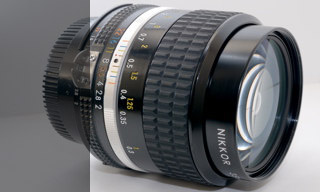
AI-S 35mm 2.0
Lenses produced as AI-S version from 1985 to 2005: 125.000 and more than 300.000 lenses before that from 1965 on in various versions. Price: US (1985): 270 $, Germany (1984): 460 DM, inlfation adjusted 2012: 387 €.
Many samples of this lens are in circulation and therefore many different reports are available on the internet. Unfortunately those reports differ quite distinctively when it comes to the optical performance of this lens. Already possessing the 35mm 1,4 Nikkor and the newer autofocus variant of this lens, I decided to try this lens myself.
Sharpness wide open is a bit better compared to the 1,4 lens when there is a light source or brighter objects in the frame. This is because of the internal flare the faster Nikkor suffers from. In darker situations the faster lens may have a slight edge, but not as much as one might think when comparing a lens wide open to one already stopped down one stop. Compared to the later AF lens sharpness wide open is a bit inferior (but not much). Stopped down performance is on par with the AF lens. At an aperture of 5,6 I would rate the 35mm 1,4 best, 35mm 2,0 AI-S second and AF 35mm 2,0 third. Wide open blue fringing can appear around highlights. Distortion an field curvature is much less pronounced than with the 1,4 Nikkor, which might make the lens more practical for landscape photography in some situations. Flare and ghosting are a lot less of a problem, too.
Overall handling is uncomplicated and easier than with the 1,4 version. You simply do not need to take so much care at f/2 and stopped further down the gapp in performance becomes smaller.
On 12 MP FX vigentting and corer softness are not an issue any more at f/5,6.

AI SC-Auto 55mm 1.2 (factory converted to AI)
This lens was the predecessor to the AI/AI-S Nikkor 50mm 1.2 (which is still produced today). The 55mm variant was produced between 1966 and 1978 with a total of about 175.000 lenses. Like all superspeed-lenses this lens is a bit dreamy wide open. On DX I found it better than the 50mm 1.4 AI-S at f/1.4 and way better than the 50mm 1.8 AF-D Nikkor at f/2.0. Nevertheless, due to performance issues at the sides of the frame up to f/4 (field curvature) not really recommended as landscape lens unless you stop is down consequently.
Sample (FX / 36 MP): 55mm f/1,2 55mm f/2,0 55mm f/4,0
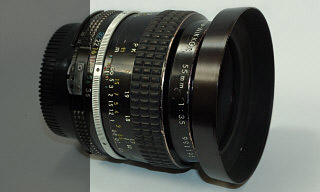
AI 55mm 3.5 Micro Nikkor
A classic Micro-Nikkor. Very sharp even wide open, suitable for close-up and distance shooting. Maximum magnification ratio of 1:2 without extension tubes.
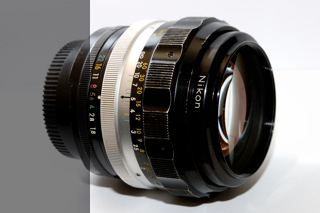
F 85mm 1.8 H
Nikon’s first 85mm 1,8 dates back to the year 1964 and was in production up to the switch to AI in 1977. More than 130.000 lenses were made in different variants (coated and multicoated)
This version here is the non-AI H.C.-type with multicoating and metal focus ring. Overall the lens has almost no weak points except maybe a bit of field curvature, which leads to slightly unsharp borders at apertures up to f/2,8. It also does not suffer from the somehow un-inspirational rendering that I attest for the 85mm 2.0. Even compared to the AF-D 85mm 1,8 this lens delivers a solid performance.
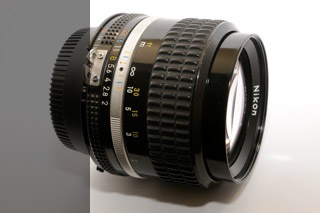
AI-S 85mm 2.0
The successor of the Nikon’s first 85mm 1,8 offering has a slower maximum aperture and an overall slightly slimmer design. In the years between 1977 and 1995 circa 200.000 lenses have been produced either as AI or AI-S version. Price: Germany (1984): 489 DM, inflation adjusted 2012: 412 €.
Being the fastest lens offering at 85mm by Nikon until 1981 when the AI-S 85mm 1,4 was presented, you can find many on these lenses on the used market.
Wide open performance suffers from a little coma with bright objects, but not as much as I would have expected. I would rate the performance at f/2 as completely usable despite a drop in the extreme corners. At f/2,8 sharpness increases to a very good level with good corners and at f/4 the lens performs to the hightest standards across the frame. At this aperture there is no drop of performance detectable, which indicates a pretty flat field of sharpness.
Vignetting is bothersome at f/2, almost gone at f/2,8 and defeated at f/4.
Color and contrast are good. Which in turn means: Not bad, not good, just plain OK without any strengths and weaknesses. It would be mean to say that this lens misses character, but somehow it is leaving me without any enthusiasm.
Samples (FX / 12 MP): 85mm 2,0 (D700) 85mm 2,8 (D700) 85mm 5,6 (D700)
